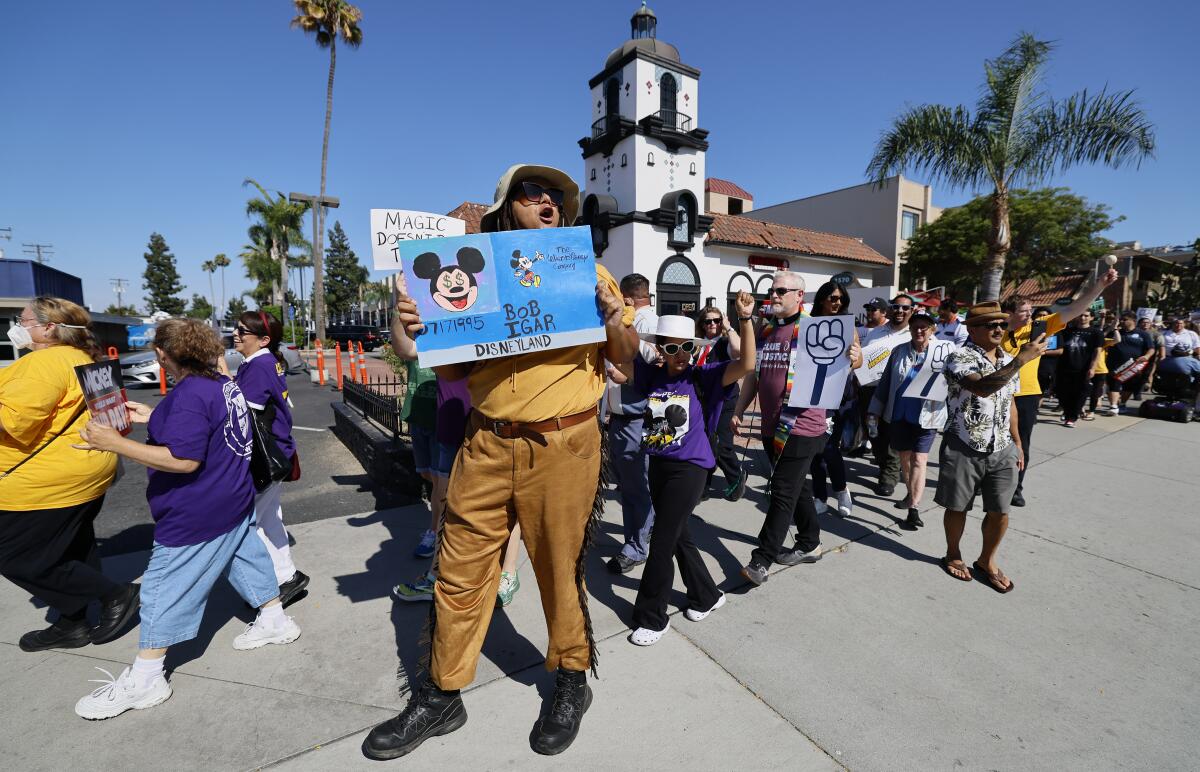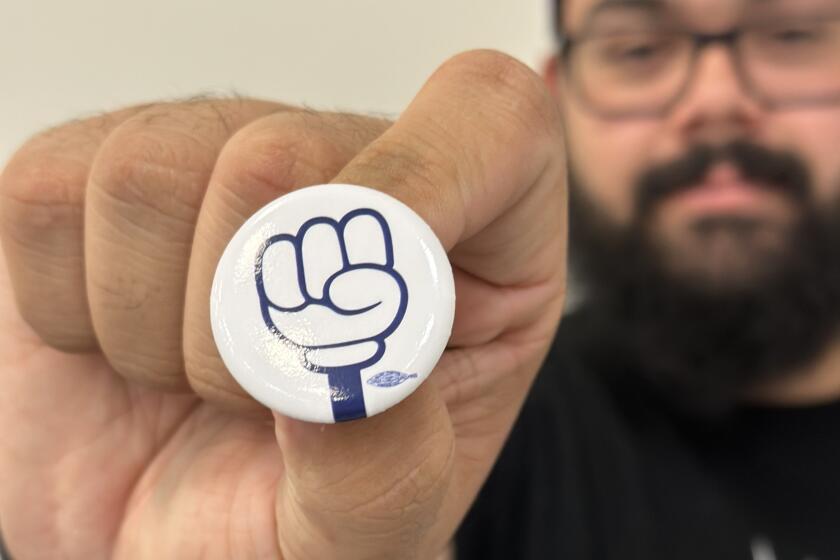Historic contract for Disney workers caps big wage gains after years of struggle

- Share via
Ellie Gonzalez remembered what it felt like to be a Disney worker in 2018 when the company paid her $11 an hour, the state’s minimum wage at the time.
She commuted to her custodial job at Disney California Adventure one day on fumes but didn’t chance stopping at a filing station due to a lack of funds.
The gambit didn’t pay off. Gonzalez’s car ran out of gas and she missed out on a day’s wages.
“It was hard making ends meet back then,” Gonzalez said. “That’s why I got so motivated to be more involved with my union.”
She became a shop steward with SEIU-USWW and helped negotiate a proposed contract for 14,000 cast members, as Disney calls its workers.
Alongside a majority of her fellow union members, Gonzalez voted on Monday to approve an agreement that raised wages from $19.90 an hour to $24 an hour, a boost she called “life changing,” especially as she’s expecting twins.
“Before these wage increases, I was very adamant about not having children,” Gonzalez said. “Now that we have won this contract, I feel like I’ll be able to make ends meet. I’ll be able to pay my bills and provide the best possible life for my two babies.”
The vote scheduled for July 19 could pave the way for a union coalition to call for a strike at Disney theme parks for the first time in 40 years.
The Master Services Council, a coalition of four major Disney unions, hailed the contract as having delivered the “biggest wage increases ever.”
At the end of its three-year term in 2026, wages will climb to $26 an hour for the Disneyland Resort’s ride operators, custodians, ticket takers, cashiers and candy makers.
“We are pleased that our cast members approved the new agreements, which, along with all we offer as part of our employment experience, demonstrate how much we value and respect them and our profound commitment to their overall well-being,” said Jessica Good, a Disneyland Resort spokesperson.

After years of court battles, a pandemic, contract fights, record inflation and even a strike authorization vote, the contract marks how Disney labor unions have transformed their workplace away from the minimum-wage employer it used to be.
The push began in 2017, when the Coalition of Resort Labor Unions (CRLU) commissioned a survey on the living conditions of its workers that informed the “Working for the Mouse” report released the following year.
“Apparently, the report that we did was the first time the unions had all done something collectively,” said Peter Dreier, an Occidental College professor and co-author of the study. “Before that, Disney used a divide and conquer strategy to try to pit the different unions against each other.”
The report revealed that 73% of surveyed workers did not make enough to cover basic expenses. Its statistics on housing insecurity, food insecurity and depressed wages served to propel a “Fight for $15” living-wage ballot measure.
Anaheim voters passed Measure L, as the law is known, in 2018. For years, it languished in court until Disney ended its legal fight against a class-action lawsuit over the wage law last year when the state supreme court declined to hear its appeal.
Ahead of contract negotiations, Disney raised wages to $19.90 an hour under the law.
“Initially, the company tried to take credit for the living-wage law,” said Rafael Rendon, a custodial worker at Disney’s California Adventure and a SEIU-USWW shop steward. “They argued that they had already given recent raises to some employees, but those were raises from Measure L and Anaheim voters.”
Frustrated by the lack of progress at the negotiating table, 99% of union members who voted on July 19 authorized an unfair labor practice strike, especially after labor charges were filed against Disney over union buttons being banned at work.
Amid a contract fight, a coalition of four major Disney unions have alleged that the company unlawfully intimidated, surveilled and disciplined workers for wearing union buttons on the job.
Days after the strike vote, Disney and the union coalition reached a tentative agreement, which was ultimately approved. Wages for workers covered under its terms now exceed the state’s $16 an hour minimum wage by 40%.
Union negotiators did make a concession where workers hired after the contract vote will make less than $24 an hour for their first year on the job.
“New hires will be paid at 90% of the base wage for those 52 weeks,” Rendon said. “While we were able to secure higher wages, the company did ask for that provision. That’s the trade-off.”
The reduced wage pans out to $21.60 an hour. After a year, new hires will get the regular raises prescribed by the contract.

Last year, Disney came to an agreement to raise wages for 8,500 food-and-beverage cast members represented by Workers United Local 50, the single biggest union at the Disneyland Resort.
Under that contract, pay is set to increase to $23 an hour on Sept. 1, meaning a majority of Disney’s 35,000-strong workforce will make above the state’s minimum wage.
“Now you can say that Disney is a good place to work,” Dreier said. “It wasn’t six years ago when we did that report.”
After the Master Services Council contract, Disney has positioned itself as offering “industry leading wages.”
The contract also secured seniority-based pay, which has been a contentious issue in past negotiations with the company offering bonuses instead.
In two years, Gonzales will have completed a decade of employment with Disney, which will entitle her to a 50-cent raise. After 20 years, the added pay will equal $2 an hour.
She now sees a future for herself working for Disney.
“It’s been a long battle and it feels like it’s never quite over,” Gonzalez said. “But I’m still proud of the work that I’ve done over these past years and the progress we’ve made. I look forward to seeing what more we can do for working class people here in Orange County.”
All the latest on Orange County from Orange County.
Get our free TimesOC newsletter.
You may occasionally receive promotional content from the Daily Pilot.








